Exploring the Migration Patterns of the Red Knot
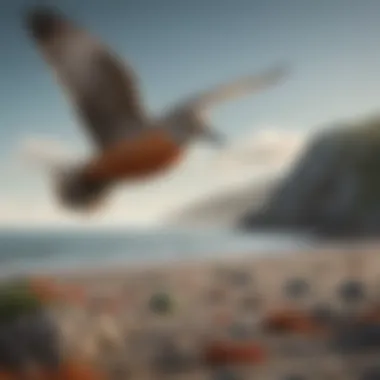
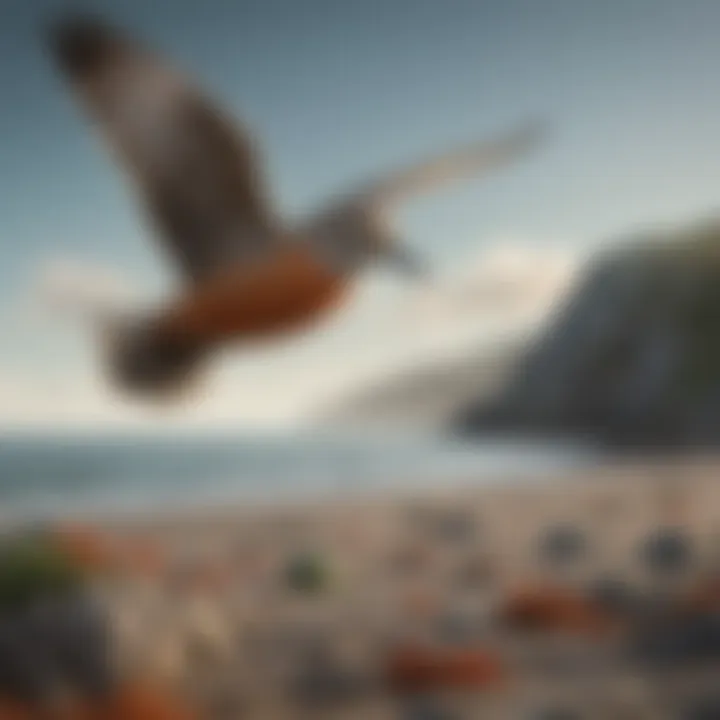
Intro
Overview of the Topic
Migration is a fundamental aspect of the red knot’s life. The necessity to move between breeding grounds in the Arctic and wintering areas in the southern hemisphere ensures that they exploit seasonal resources effectively. This journey isn’t merely about survival; it's integral to maintaining the delicate balance of coastal ecosystems.
Key Natural Resource Issue
The natural landscapes that support these migrations have faced significant threats over the years. Coastal habitats have been increasingly encroached upon by urban development, pollution, and climate change. These factors cumulatively challenge the very essence of what keeps the red knot thriving. Indeed, re-establishing the equilibrium of these ecosystems is crucial—not only for the birds but for countless other species that share their habitat.
Background Information on Significance
The red knot's role extends beyond its immediate ecological interests. As a species critically intertwined with coastal environments, they serve as indicators of the health of broader ecosystems. Therefore, recognizing the importance of conserving their migratory pathways is indispensable.
Current Status and Challenges
With a sharp decline in their population numbers, the plight of the red knot is alarming. According to recent studies, their population has diminished by nearly 75% over the last few decades. Factors contributing to this drop include:
- Habitat Loss: Coastal development not only destroys resting and feeding areas but disrupts the migratory routes essential for survival.
- Climate Change: Alterations in climate are affecting food supplies and breeding conditions. Warmer winters and changing weather patterns can make migratory timing more volatile.
- Pollution: Contaminants in the oceans and on beaches impact the health of both the birds and their food sources.
"The migration patterns of the red knot are a barometer for the ecological state of their habitats, highlighting the intricate connections within nature."
Sustainable Solutions
Addressing the issues faced by red knots requires a multifaceted approach. Conservationists and communities can play pivotal roles in securing the future of these birds. Possible solutions include:
- Habitat Restoration: Rehabilitating coastal areas to reinstate nesting grounds and feeding habitats.
- Legislation and Policy Making: Implementing legal frameworks that protect migratory birds and their habitats.
- Community Engagement: Educating local communities on the importance of these birds can garner support for conservation efforts.
Examples of successful conservation efforts can be found around the globe, where organizations have restored critical habitats or established regulations to protect shorebirds. Such case studies demonstrate the effectiveness of collective action.
Impact and Importance
The migration of the red knot is more than an avian spectacle; it reflects wider ecological dynamics. Their presence signifies thriving coastal ecosystems, which in turn support diverse marine life and local communities. The preservation of their migratory pathways not only safeguards their species but ensures the health of ecosystems for future generations.
Conservation efforts are not merely a benefit for these birds but are crucial for maintaining biodiversity and ecological balance as a whole. Protecting the red knot thus stands as a testament to the broader commitment to environmental stewardship.
Prolusion to Red Knot Migration
At the heart of the avian realm lies a remarkable story of endurance, instinct, and survival: the migration of the Red Knot. This small shorebird, renowned not only for its striking appearance but also its whirlwind travels, captivates the attention of ornithologists and nature enthusiasts alike. Understanding the migration patterns of the Red Knot is pivotal, for not only does it reveal the intricacies of this species’ life cycle, but it also sheds light on broader ecological dynamics that impact various habitats around the world.
Migratory behavior is deeply woven into the fabric of the Red Knot’s identity. Each spring and fall, these birds embark on journeys that can stretch over thousands of miles, traversing treacherous terrains and weather patterns that can turn the calmest of days into a remarkable battle against nature. By studying their migration, we gain insights into their nutritional needs, breeding habits, and the environmental factors that exert stress on their populations. The way they navigate through complex ecosystems reminds us of the delicate balance between species survival and the impacts of human activity.
The importance of understanding the journey of the Red Knot cannot be overstated. As these birds venture across continents, they connect various ecosystems and act as indicators of environmental health. Their migratory paths often highlight key regions that require conservation efforts. By preserving these areas, we not only protect the Red Knot but also support the diverse array of wildlife that shares their habitats.
Comprehensive Examination
By the time we wrap up, readers will possess a clearer understanding of how vital these birds are to the environment and why conservation efforts must prioritize these migratory routes. As we navigate through this narrative, we will discover the significant threads that bind the Red Knot to the fabric of our natural world.
"Migration is a spectacular journey—an ongoing testament to survival amidst ever-changing landscapes and climates. Understanding it is understanding nature itself."
In summary, the exploration of Red Knot migration is not just about one species but about the interconnectedness of life and the environment. This discussion serves not only to enlighten but also to engage conservationists, students, and environmentalists in the shared responsibility of safeguarding our planet's avian travelers.
Migration Patterns and Routes
Understanding the migration patterns and routes of the red knot is crucial for grasping how these remarkable shorebirds navigate vast geographical expanses during their migratory journeys. These patterns not only underpin their survival but also highlight the interconnectedness of ecosystems they traverse. Studying these migration routes provides insights into the species' adaptability and the challenges posed by environmental changes.
The red knot embarks on a migration journey that takes it from breeding grounds in the Arctic down to wintering habitats in various coastal regions. This seasonal trek is not merely a change of scenery; it's a vital part of the bird's life cycle, ensuring access to necessary resources such as food and suitable habitats for breeding. As migratory birds, red knots have developed innate navigational skills, yet such journeys are fraught with threats that, without proper conservation efforts, could jeopardize their populations.
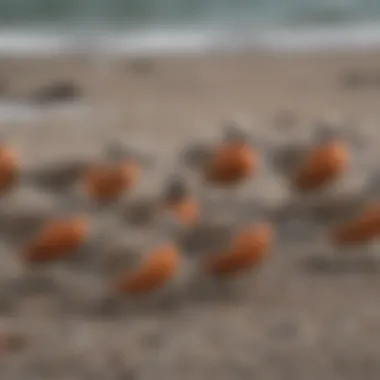
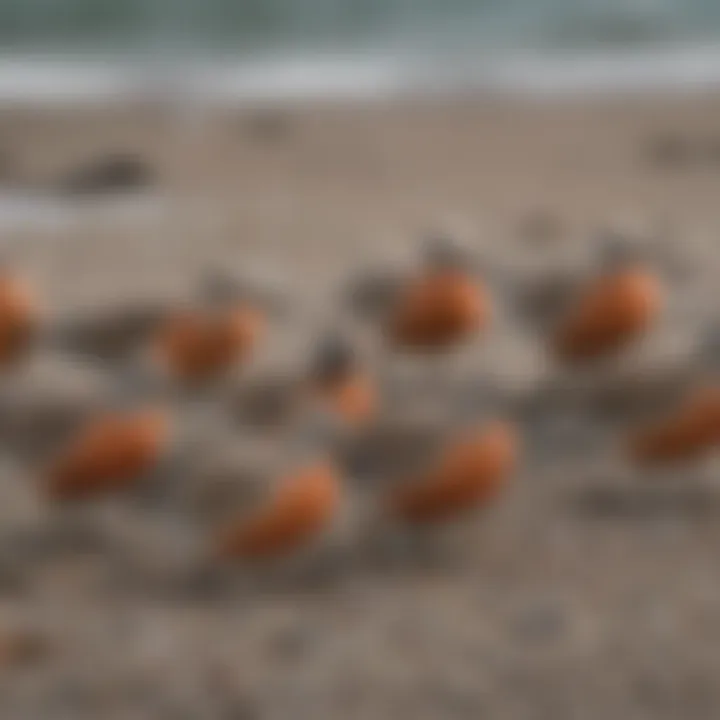
Historical Migration Paths
Historically, red knots have followed well-established migration paths that reflect their need for certain environmental conditions and food availability. For instance, many populations migrate from breeding areas in the Canadian Arctic and Alaska, flying south along the eastern shore of North America. These routes have been utilized for generations, shaped by the birds' instinct to find food-rich stopover sites. That said, significant changes in climate and human encroachment have started influencing these historical paths.
"The red knot's migratory journey is a testament to resilience, yet it reflects the pressures of modernity, whispering that every wingbeat counts in the battle for survival."
Modern Migration Tracking Technologies
In recent years, modern technologies have revolutionized the study of the red knot's migration. With the advent of GPS tracking, researchers can monitor the positioning of these birds in real-time. Small satellite transmitters are attached to the birds, allowing ecologists to gather data on their routes, stopover durations, and environmental interactions. This technology aids in identifying critical habitats that need protection.
Moreover, the use of remote sensing technology provides a broad perspective of habitat changes and availability, further guiding conservation efforts. However, reliance on technology also raises questions about its sustainability and implications for the birds' natural behaviors. While high-tech solutions provide invaluable data, it’s essential to ensure this approach doesn’t intrude on the natural patterns of migration.
Geographical Challenges in Migration
The red knot's migration isn't just a straight shot from point A to point B; it navigates a complex landscape filled with geographical challenges. Coastal habitats, estuaries, and wetlands form an integral part of the red knot's journey, but they also present obstacles such as habitat loss, pollution, and climatic fluctuations.
For instance, coastal erosion and rising sea levels due to climate change drastically alter feeding grounds critical for the red knot’s sustenance. The Delaware Bay, a key stopover site for these birds, faces significant environmental pressures that impact food availability. Furthermore, factors like urban development and agricultural expansion can disrupt the migratory routes, making it increasingly difficult for these birds to find safe and resource-rich areas to rest and feed.
Understanding these challenges is vital for developing conservation strategies that address both the immediate threats to habitats and long-term ecological changes affecting the red knot's migration.
Feeding Habits During Migration
The act of migrating is no small feat, especially for a creature as small as the red knot. As these shorebirds traverse across oceans and continents, their feeding habits become pivotal to their survival. The ability to find adequate food sources during migration is not just a matter of convenience; it is a crucial determinant of their overall health and successful reproduction. Understanding how these birds meet their nutritional needs while journeying across vast landscapes helps shed light on the ecological challenges they face.
Nutritional Needs of the Red Knot
The red knot's diet primarily consists of invertebrates, with a particular fondness for small mollusks, crustaceans, and worms. When preparing for migration, these birds need to stockpile energy reserves in the form of fat to sustain long flights, sometimes covering 7,000 miles. While migrating, their metabolic rates increase, and their bodies demand more energy than usual. It is essential for them to consume nutrient-rich foods at key stopover points to replenish these reserves.
To effectively meet their energy requirements during different migration phases, red knots exhibit fascinating feeding behaviors – from foraging in marine intertidal zones to raiding mudflats. This adaptability aids them in optimizing their diets according to what is readily available. A substantial intake of food will directly enhance their migratory capacity, enabling them to arrive at breeding sites in good health.
Key Stopover Sites for Feeding
Stopover sites function like rest areas along the red knot's migratory route. These locations are not created equal; they are critical for the birds' feeding and recovery.
Some notable stopover habitats include:
- Delaware Bay: Known for its abundant supply of horseshoe crab eggs, this region offers a seasonal bonanza for migrating shorebirds.
- Bahia Ligure, Brazil: A nutrient-rich ecosystem where red knots can refuel before undertaking the final leg of their journey.
- San Francisco Bay: A diverse estuarine environment that provides an array of food sources, making it a valuable stop, particularly in spring.
These sites are meticulously chosen based on food availability, safety from predators, and proximity to migration routes. However, the numbers of red knots utilizing these stopovers can swell significantly during migration seasons, putting stress on the available resources due to competition.
Impact of Food Availability on Migration Success
The reality is that a red knot’s journey can only be as successful as the resources it encounters. Limited food availability at stopover sites can result in detrimental effects on their migration. If food is scarce, birds may experience increased fatigue, lower fat reserves, and even delayed departures for breeding grounds.
Several factors influence food availability:
- Seasonal variations can impact local invertebrate populations.
- Human activities, such as coastal development and pollution, can degrade habitat quality.
- Climatic changes, like rising sea levels, pose bigger threats to their feeding habitats.
It’s crucial to emphasize that conservation efforts must focus on safeguarding these essential stopping points to ensure the survival of the red knot. By fostering healthy ecosystems and reducing human pressures, we can help secure a future for this remarkable migratory bird.
"If we don't protect the places that red knots rely on during their migration, we risk losing these avian travelers for good."
In summary, the feeding habits of red knots during migration play a fundamental role not just in their survival, but also in the overall health of the ecosystems they inhabit. This intricate relationship underlines the need for concerted conservation efforts aimed at protecting critical feeding habitats as these magnificent birds journey across the globe.
Breeding Behavior and Habitats
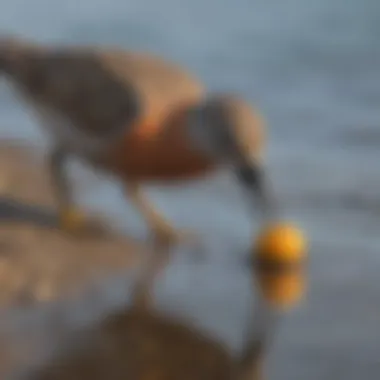
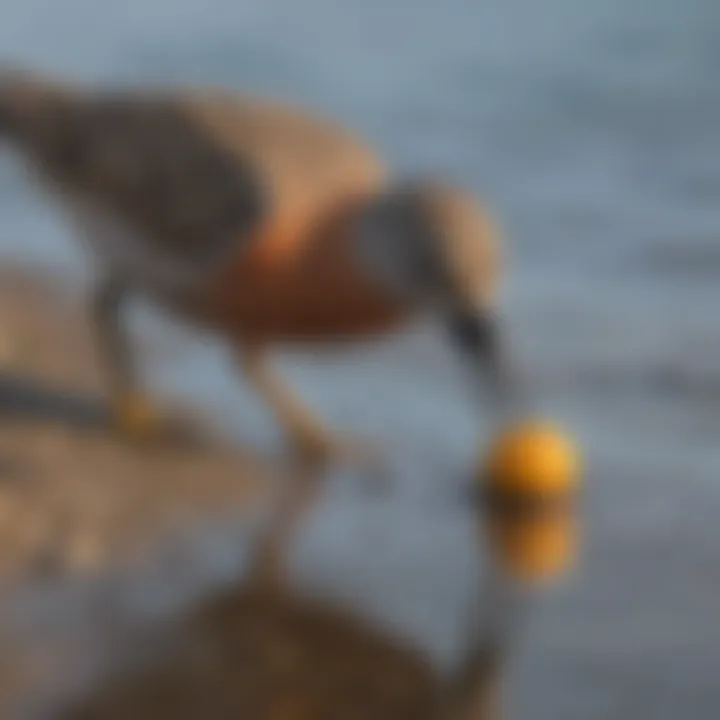
Breeding behavior and habitats are crucial aspects in the life of the red knot. These elements don't just influence their reproductive success, but they also play a significant role in their overall migratory patterns. Understanding where and how these birds breed helps researchers and conservationists identify critical areas that need protection. The breeding season typically coincides with their arrival at northern tundra regions, where ample food and suitable nesting sites are available.
Red knots are known for their fidelity to breeding sites, often returning to the same locations year after year. This behavior underscores the importance of maintaining these habitats, as the loss of such locations can have drastic effects on their populations. Additionally, climate change poses a challenge to these naturally pristine environments, making it imperative to delve into the factors shaping their breeding behaviors and habitats.
Breeding Locations of the Red Knot
The red knot primarily breeds in the Arctic tundra, an expansive region that stretches across Canada, Greenland, and Siberia. These nests are generally constructed in sparsely vegetated areas, which provide some cover from predators. Breeding locations are often determined by the availability of food resources and the type of vegetation present.
During the breeding season, red knots prefer well-drained areas that are close to water sources. Such locations not only offer a nearby supply of food but also maintain sufficient moisture levels for the nest. Observations suggest that male red knots are often the ones to scout breeding territories, showcasing their distinctive behavior in site selection.
Nest Building and Egg Laying
Nest building is an intricate process for red knots. They generally scrape a shallow depression in the ground, lining it with pebbles and plant material, creating a safe space for their eggs. The typical clutch comprises three to four eggs, which are laid within a few days of each other. Notably, the reddish-brown coloration of the eggs helps them blend into the surrounding environment, providing an added layer of protection from potential predators.
Egg laying usually occurs between late May and early June, with the specific timing varying based on migration patterns and local environmental conditions. Both parents participate in incubating the eggs, taking turns to ensure warmth and safety. This cooperative nesting behavior is vital, as it maximizes the chances of successful hatching while minimizing exposure to predators.
Parental Care and Chick Development
Once the eggs hatch, the role of the parents shifts towards caring for their young. Chick development is extremely rapid; red knot chicks are precocial, meaning they are relatively independent and can leave the nest shortly after hatching. This notable trait is advantageous, as it allows them to forage for food almost immediately, reducing the time spent vulnerable to predators.
Parent red knots continue to guide their chicks towards feeding areas, helping them to find small invertebrates that they thrive on. Fledgling success relies heavily on the parents' ability to provide suitable foraging opportunities. This connection between parental care and chick survival emphasizes the intricate balance of breeding success and resource availability in the habitat.
"In the world of the red knot, nurturing the next generation is as much about survival as it is about instinct. Every decision made during breeding season has consequences that echo through migration and beyond."
Through examining the breeding behavior and habitats of the red knot, it’s clear that these areas are not just crucial for reproduction but are also intertwined with environmental factors that affect migration. Protecting and monitoring these specific breeding sites ensures a continued legacy for future generations of these remarkable shorebirds.
Environmental Influences on Migration
Understanding environmental influences on migration is crucial for grasping the complex dynamics surrounding the red knot's annual journey. Migration is not merely a behavioral trait; it’s a response to the challenges posed by changing ecosystems, varying food availability, and the stressors of climate change. As the seasons shift, the red knot relies on specific environmental cues that not only guide its travels but also dictate its survival.
Climate Change and Its Effects
Climate change has emerged as a formidable challenge for the red knot. Increasing temperatures have a multitude of effects on the migratory patterns of these shorebirds. Firstly, it alters the timing and availability of critical stopover sites. As wetlands and coastal areas experience shifts in seasonal patterns, the food sources that red knots depend on can become scarce.
Moreover,
"The effects of climate change extend beyond simple temperature increases; they can destroy habitats essential for breeding and feeding."
Wetland loss due to rising sea levels are not theoretical; they are very much real, and red knots are feeling the pinch. With longer migrations and limited resources, the strain on these birds is palpable. They may find themselves arriving at their breeding grounds later than usual, disrupting their reproductive cycles.
Habitat Loss and Degradation
The evolution of urban landscapes, agriculture, and industry has taken a toll on natural habitats along the migratory routes of the red knot. Coastal habitats, specifically, are diminishing, putting immense pressure on these birds.
Key factors include:
- Urban Expansion: Increased development along coastlines has led to the destruction of vital feeding and nesting areas.
- Pollution: Contaminants can affect the health of the birds and the food sources they rely on. The introduction of heavy metals or plastic can drastically alter the ecosystem balance.
- Climate-Induced Changes: As discussed earlier, habitat degradation often has a cascading effect, with warming temperatures forcing species migration and leading to conflicts over dwindling resources.
In some regions, stopping points critical for red knots have been transformed into bustling urban centers, leaving birds without a place to rest and refuel. This further exacerbates the struggle for survival during migration.
The Role of Coastal Ecosystems
Coastal ecosystems serve as a lifeline for the red knot, acting as feeding grounds and rest areas along their treacherous routes. These environments are rich in biodiversity, providing the essential nutrients that sustain migrating birds. In particular:
- Intertidal Zones: These areas are teeming with food sources, such as shellfish and worms, which are crucial during the migration phase. The availability of these resources can determine whether a red knot will thrive or struggle.
- Salt Marshes and Estuaries: They play a vital role in maintaining ecological balance, serving as natural barriers against the impacts of climate change while providing critical habitats.
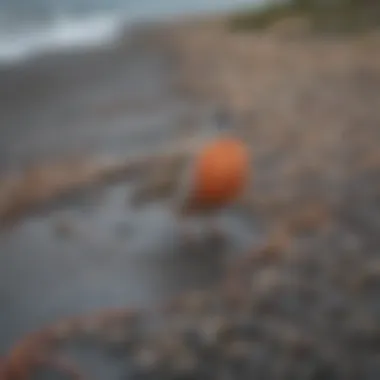
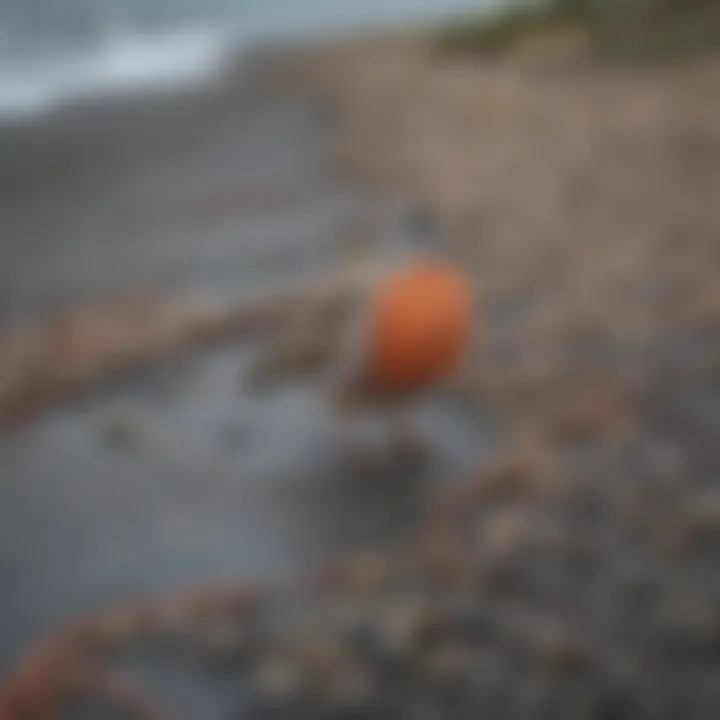
Yet, coastal ecosystems are increasingly under threat from human activities and climate shifts, making their preservation paramount.
In summary, the environmental influences on the migration of the red knot are significant and multifaceted. The interplay of climate change, habitat loss, and coastal ecosystems forms a complex web that shapes the destiny of this remarkable bird. Recognizing and addressing these challenges is crucial not merely for the survival of the red knot, but for the health of our planet as a whole.
Conservation Challenges
The survival of the red knot is increasingly jeopardized by multiple conservation challenges. Understanding these challenges is crucial in raising awareness about the species and fostering effective preservation strategies. As migratory birds, red knots traverse vast distances, encountering numerous risks that endanger their populations. It's important to address these challenges not merely as isolated issues but as interconnected elements that contribute to the overall health of red knot populations.
Threats to Red Knot Populations
Several key threats impair the well-being of red knot populations:
- Habitat loss: Urbanization, coastal development, and industrial projects have stripped away the essential habitats required by red knots during their long journeys. This rapid loss of areas where they feed, rest, and breed severely compromises their chances of survival.
- Climate change: The scrappy effects of climate change cannot be ignored. Change in weather patterns can impact the availability of food and suitable breeding sites. Rising sea levels threaten habitats that red knots rely on along their migration routes.
- Human disturbance: High levels of recreational activities along coastal areas can drive red knots away from critical feeding and roosting sites, often when they need it the most. Frequent disturbances can lead to stress and reduced foraging time, ultimately affecting their health and migration success.
These challenges necessitate urgent action to ensure that red knots receive the attention they require to thrive.
Legislation and Protection Efforts
In response to the myriad threats encountered by red knots, various legislation and protection efforts have been initiated:
- International treaties: Reinforced by agreements such as the Migratory Bird Treaty Act, these laws aim to protect migratory birds, including red knots, from hunting, habitat destruction, and other threats.
- Establishment of protected areas: Many countries have started designating protected areas that encompass crucial habitats for the red knot. These zones are designed to provide safe havens during migration and breeding.
- Bans on harmful activities: Some specific regulations are put in place to restrict construction activities during breeding seasons or to limit access to key habitats by the general public.
Adopting and enforcing effective legislation is fundamental for preserving red knots. However, it's paramount that these laws are not only in place but are actively communicated and supported by the public.
Community Involvement in Conservation
Engaging local communities in conservation efforts can massively bolster the fate of red knots. Here are some impactful ways communities can contribute:
- Education and awareness programs: By informing local communities about the ecological importance of red knots, residents can be inspired to become advocates for conservation. Programs can include talks, workshops, and school projects that highlight the significance of maintaining healthy ecosystems.
- Volunteer initiatives: Organizing activities such as beach clean-ups or habitat restoration days offers community members a hands-on approach to conservation. Such participation fosters a sense of ownership and responsibility towards the environment.
- Citizen science projects: Involving local people in monitoring red knot populations or their habitats allows communities to contribute data and helps foster a deeper connection with the species. Participants become more invested when they see their active role in protecting these birds.
By tapping into the community's potential, conservation efforts can gain strength and resilience, forming a united front to protect the red knot.
"Conservation is a local issue, and it requires local solutions. Engaging communities is a vital element in ensuring the long-term survival of species like the red knot."
Through understanding and addressing these conservation challenges, the trajectory of red knots can pivot towards a more hopeful future. The combined efforts of legislation, community engagement, and an awareness of threats can collectively create a safeguard for this iconic migratory bird.
Future of Red Knot Migration
The future of the red knot migration holds significant importance, not just for ornithologists or avid birdwatchers, but for the broader environmental community. As these shorebirds embark on their long journeys, they serve as indicators of ecological health across the globe. Their migratory patterns reflect the state of our natural habitats, and any changes in their behavior signal shifts in environmental conditions. Understanding the factors that can impact their future migration is key to effective conservation strategies.
Research and Monitoring Initiatives
Research into the migration of red knots is vital for the ongoing protection of the species. Continuous monitoring through various initiatives provides insights into their current patterns, habitats, and the challenges they face. For instance, scientists are employing satellite tracking technology to precisely follow the flyways of these birds. This technology has led to discovering new stopover sites that might not have been previously recognized.
Some important points include:
- Collaboration: Work conducted by organizations such as the Wadden Sea Flyway Initiative and American Bird Conservancy facilitates international efforts to study red knot migration.
- Data Gathering: Citizen science projects allow birdwatchers to report sightings, contributing to a comprehensive understanding of red knot populations and migration.
- Adaptive Management: Research findings help inform conservation practices and policies, enabling adaptive management of essential habitats along migration routes.
"Research is not just an academic exercise; it’s the backbone of effective conservation efforts that can ensure the survival of vital species like the red knot."
Sustainable Practices for Habitat Preservation
Sustainable practices are essential for preserving the habitats crucial for red knots during their migration. As coastal areas face pressures from urban development, climate change, and pollution, it becomes imperative to implement measures that protect these ecosystems. Key actions include:
- Wetland Restoration: Reviving degraded wetlands can provide much-needed resources for the red knots. These environments are not just important for feeding, but they play a role in their breeding success as well.
- Responsible Tourism: Encouraging eco-friendly tourism that respects wildlife habitats ensures that these areas remain pristine and can support migratory birds without undue interference.
- Land Use Planning: Collaboration between conservationists, local communities, and policymakers is crucial in creating land use plans that prioritize the needs of migrating species.
Role of Technology in Conservation
The incorporation of technology into conservation efforts for red knots has revolutionized how we understand and protect these birds. Innovative approaches include:
- Remote Sensing: This allows for the analysis of habitat changes over time. By monitoring land use changes through satellite imagery, researchers can identify critical areas that require immediate protection or restoration.
- Mobile Applications: Citizen science apps have made it easier for ordinary people to contribute to conservation efforts. Birdwatchers can document sightings, which helps build a large database on the mobility and health of red knot populations.
- Artificial Intelligence: AI technologies enable researchers to predict migration patterns and assess the impact of various threats, such as habitat loss or climate change, with greater accuracy.



